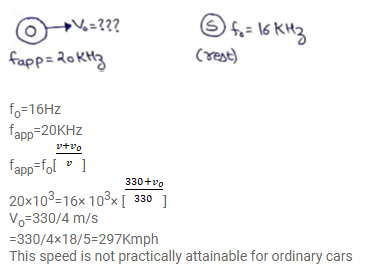Question:
A traffic policeman sounds a whistle to stop a car-driver approaching towards him. The car-driver does not stop and takes the plea in court that because of the Doppler shift, the frequency of the whistle reaching him might have gone beyond the audible limit of $25 \mathrm{kHz}$ and he did not hear it. Experiments showed that the whistle emits a sound with frequency closed to $16 \mathrm{kHz}$. Assuming that the claim of the driver is true, how fast was he driving the car? Take the speed of sound in air to be $330 \mathrm{~m} \mathrm{~s}^{-1}$. Is this speed practical with today's technology?
Solution:

